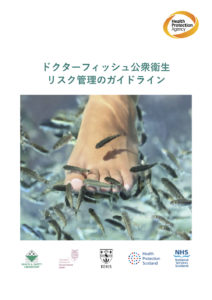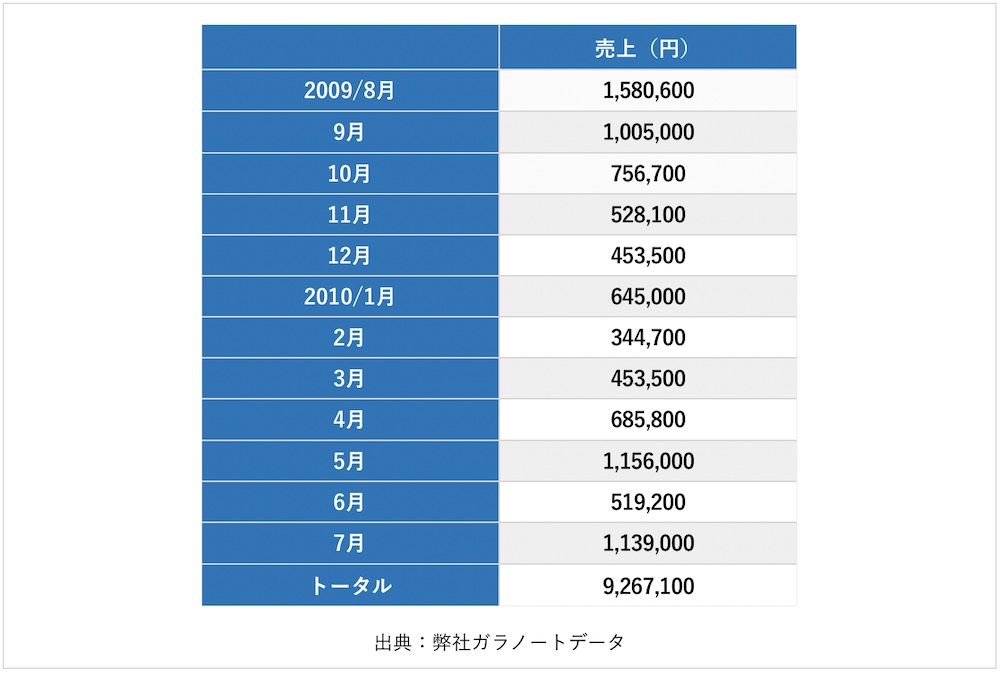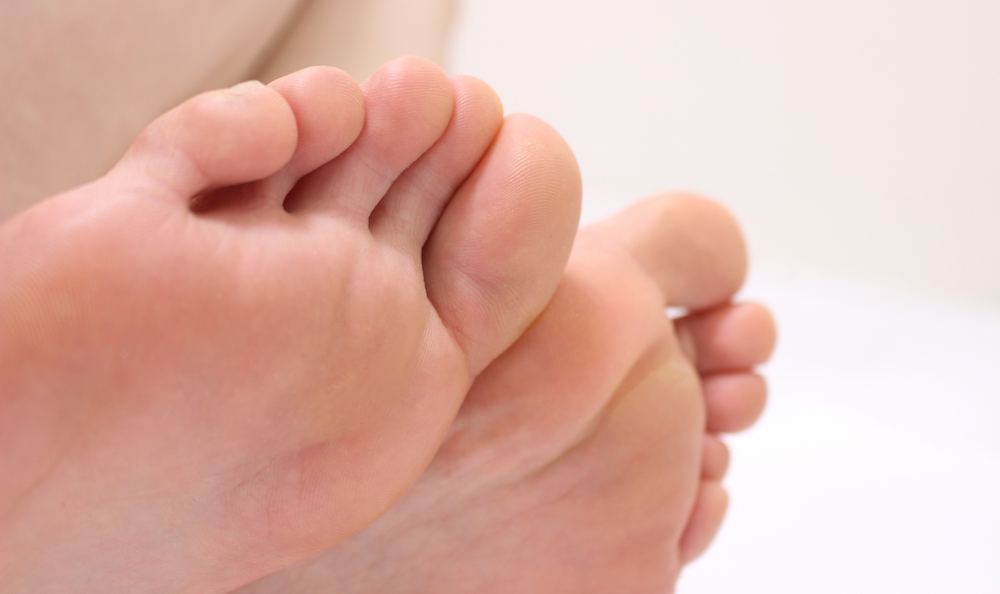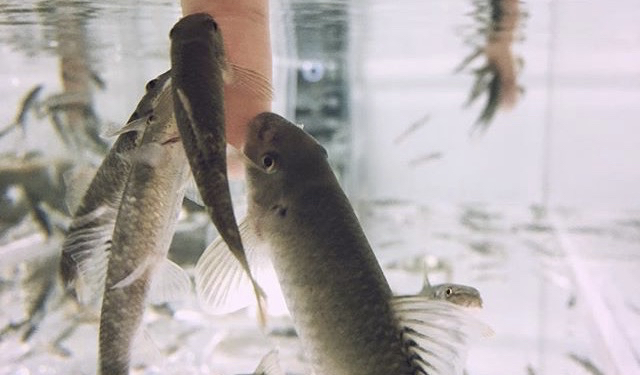
突然だが、あなたはドクターフィッシュのガイドラインをご存知だろうか。
そして、そのガイドラインを発表した英健康保護局(Health Protection Agency:HPA)が、どのような理念を持って、ドクターフィッシュ体験の注意喚起をしたか知っているだろうか。
おそらく、大半の方はあまり知らないと答えるだろう。そして、「知らない」と答えた方は、きっと「感染症の危険があるのでは・・」と思い込んで、ドクターフィッシュの体験を躊躇しているのではないだろうか。
もしくは、すでに体験をした後で、何らかの症状が出てくるのではないかとビクビクしている方もいるだろう。
もっと言うなら、ドクターフィッシュのサービス提供者のあなた自身が、本当のリスク管理を理解しているだろうか。
もし、あなたがそうした不安を取り除き、安心してドクターフィッシュを体験したいのであれば、弊社ガラノートが日本語に和訳したガイドラインをじっくりと読み込んで、体験するにあたっての基礎知識を抑えておいてほしい。
そうすれば、どうしたら安全にドクターフィッシュの体験をできるかが全て分かるようになることをお約束する。
それでは、早速ご覧いただこう。
目次
1、ドクターフィッシュのガイドラインを発表した理由と目的
そもそも何故、英健康保護局(HPA)は、ドクターフィッシュのガイドラインを発表したのだろうか?
それは、英国でドクターフィッシュを提供する施設の数が急激に拡大したことが背景にある。
2011年春、環境保健従事者の調査によると、英国の119地方自治体で279箇所のドクターフィッシュ施設が確認され、さらに拡大計画がなされていた。これは、全地方自治体の約1/3を占め、ビジネスが爆発的に展開したことを意味している。
ドクターフィッシュに効果があり、その効果に期待する人が急増したということだ。ドクターフィッシュの効果について詳しく知りたい方は『ドクターフィッシュの効果を検証!797人の体験者アンケートで解説』をご参考いただきたい。
つまり、ドクターフィッシュの治療法が比較的新しく、ビジネスの成長が非常に早い一方で、感染制御の課題に対する取り組みに大きな価値があるからガイドラインの制作に取り組んだのだ。
This type of treatment is relatively new and I am delighted to recommend and endorse this guidance which will be of great value to members of the Chartered Institute of Environmental Health as they seek to address the infection control issues presented by the growth of businesses seeking to offer this treatment service to customers.
この治療法(ドクターフィッシュ)は、比較的新しいもので、このガイドラインを推奨し支持します。その理由は、このガイドラインが公認環境衛生研究所のメンバーにとって、ドクターフィッシュのビジネスが成長を示すように、感染制御の課題に取り組む大きな価値があるからです。
出典:Guidance on the management of the public health risks from fish pedicures
そして、ドクターフィッシュを体験するユーザーおよびサービス提供者のために、各分野の専門家が集まり、感染の拡散を抑制し、安全な運営方法の指導や正確な情報提供を促すことがこのガイドラインの主な目的だ。
次に、英国以外の国際状況をご覧いただこう。
2、アメリカ18州での使用禁止は感染が理由ではない
世界各地でドクターフィッシュの使用を伝えられている一方で、2011年8月時点で、科学的証拠が不足しているにも関わらず、アメリカの18州で禁止されている。
この禁止された理由は、主に美容に適用される規則に違反しているからだ。
具体的に説明すると、アメリカにおいて、魚を含むすべての動物の使用がサロンでは禁止されているのだ。
つまり、日本より厳しいとされるアメリカ動物福祉法では、「動物(ここではドクターフィッシュ)が、餓えた状態で古い角質を食べる可能性がある」と懸念され、動物愛護に反する虐待という観点から18州で禁止とされているのが現状だ。
従って、この結果は、ドクターフィッシュによる感染症の報告文書がないことを確認した上で禁止となっているのだ。
では、どんな理由で18州でのドクターフィッシュの使用が禁止になったのか、米国疾病対策センター(CDC)が公表した内容を見ていこう。
2-1. ドクターフィッシュが禁止になった7つの理由
ほとんどの禁止は、以下の理由の少なくとも1つに基づいている。
- The fish pedicure tubs cannot be sufficiently cleaned between customers when the fish are present.
- The fish themselves cannot be disinfected or sanitized between customers. Due to the cost of the fish, salon owners are likely to use the same fish multiple times with different customers, which increases the risk of spreading infection.
- Chinese Chinchin, another species of fish that is often mislabeled as Garra rufa and used in fish pedicures, grows teeth and can draw blood, increasing the risk of infection.
- According to the U.S. Fish and Wildlife Service, Garra rufa could pose a threat to native plant and animal life if released into the wild because the fish is not native to the United States.
- Fish pedicures do not meet the legal definition of a pedicure.
- Regulations specifying that fish at a salon must be contained in an aquarium.
- The fish must be starved to eat skin, which might be considered animal cruelty.
- ドクターフィッシュ水槽は、魚が存在するときに顧客間で十分に洗浄することができない。
- 魚自体は、顧客間では消毒することはできない。魚のコストのために、サロンの所有者は、異なる顧客と同じ魚を複数回使用する可能性が高く、感染拡大のリスクが高くなります。
- 中国の親親魚は、ガラルファとして誤って使用され、歯を成長させるため血液を採取して感染のリスクを高める魚種です。
- 米国魚類野生生物局よると、魚が米国原産でないため、ガラルファが野生に放出された場合、自然の植物や動物の生活に脅威を与える可能性があります。
- ドクターフィッシュは、ペディキュアの法的定義を満たしていません。
- サロンでその魚を指定する規則は、水槽に入れなければなりません。
- 魚は、動物の残虐行為とみなされるかもしれない皮膚を食べるために飢えている必要があります。
出典:米国疾病対策センター
2-2. カナダ4州で禁止される一方で、他州は法的に認可されている
カナダでは、水槽内のドクターフィッシュは、利用者間で、掃除、消毒、殺菌ができないという理由で、これまでオンタリオ州、ブリティッシュ・コロンビア州、アルバータ州、マニトバ州で禁止されている。
Guidance from Ontario states that “water samples collected from the intended footbath-type tanks showed an overgrowth of E. coli, total coliforms, Staphylococcus and Pseudomonas bacterial species. As no fish pedicures had been performed, it is likely that the fish themselves were the source of these bacterial species.”
オンタリオ州の手引きでは、「フットバスタイプ(足湯タイプ)用の水槽から採取された水サンプルは、大腸菌、全大腸菌群、ブドウ球菌およびシュードモナス細菌種の過増殖が見みられました。フィッシュセラピーは、魚自体がこのような細菌の根源である可能性が高い」と記しています。
出典:Guidance on the management of the public health risks from fish pedicures
一方で、上記の問題が具体的にすべて対処されている訳ではないが、ドクターフィッシュは、カナダの上記以外の州や地域で法的に認可されているのだ。
2-3. 海外と日本の入浴文化の違い
私たち日本では、全国各地に温泉があり、家族との入浴は勿論、赤の他人と気にもせずに同じ浴槽に入浴する習慣がある。
例えば、あなたは入浴前に水虫や出血している切り傷を患った人をわざわざ確認するだろうか。同じ浴槽にそのような方がいたら勿論、気分はよくない。しかし、多くの方が、そういった点に注意を向けずに普段から入浴しているのではないだろうか。
一方、アメリカでは、このような状況から感染の拡散を制御することに保健所が厳しいのだ。
従って、感染症への懸念は、入浴文化がそれぞれの国で違うことも理由のひとつではないだろうか。
3、感染が拡散する3つの可能性
と、その前に、感染が拡散する原因元となる「菌」の存在をご説明しておこう。
英健康保護局(HPA)は、菌が人に感染し、拡散していくことを抑えなくてはならない、と説いている。
しかし、菌には良質なものから悪質なものまで存在する。実は、魚類が水質環境の中で、生存していくには「菌」が必要不可欠になる。水槽飼育では、生体が糞をすると水質が悪化してしまう。その有害な糞を無害化し住みやすい水質環境にするためには、バクテリアの菌による濾過が必要なのだ。
濾過が不十分になると、生体の体調を崩すきっかけとなり徐々に状態が悪くなり最悪死んでしまう。そのために、濾過能力を強化し、生体生存のために必要な良質な菌を維持していかなくてはならないのだ。
結果として、感染元と指摘される菌を排除することは、ドクターフィッシュを飼育している以上、不可能となるのだ。
水質環境にについては『抜群な食いつきのために絶対やるべき5つのドクターフィッシュ飼育法』でご確認いただきたい。
では、ドクターフィッシュによる感染が確認されていないにも関わらず、何が感染の危険性を高めるのかを英健康保護局(HPA)が発表したガイドラインを見ていこう。
ガイドラインでは、以下の状態の人がドクターフィッシュを利用した際に感染リスクが高くなると発表している。
The risk of infection will be increased if the client has an underlying health condition that reduces the effectiveness of their natural defences against infection, or if there is broken skin.
ドクターフィッシュ利用者の体力が、免疫低下のような健康状態、または皮膚状態が健全でない場合には、感染リスクが高くなります。
出典:Guidance on the management of the public health risks from fish pedicures
上記の状態の方が、ドクターフィッシュを体験すると感染リスクが高まる。その伝染経路は以下3つだ。
- 魚から人への感染
- 水から人への感染
- 人から人への感染
この3つの内容は、ガイドラインで詳しく説明をしている。だが、専門的な用語が多いため興味がある方はご覧いただきたい。難しく感じる方は、次の「4、ドクターフィッシュを避けたほうがいい人8つの条件」を読み込んで行こう。
3-1. 魚から人への感染(感染リスクは非常に低い)
3-1-1. Bacterial infections
Erysipelothrix rhusiopathiae and Streptococcus iniae are both typically associated with handling fish out of water and zoonotic infection is rare even in those who handle fish frequently. Fish infected with Streptococcus iniae have a high mortality and are likely to die quickly. In this setting, both bacteria are considered to be low risk human pathogens.
Aeromonas species are found in many aquatic habitats (including drinking water) and in association with fish. Some can cause infection in situations where there is invasive contact with the skin, for example following water-related trauma10, and infections associated with medicinal leech treatment have been reported from a number of countries.11,12 Reports of serious infections are rare and have been associated with immunocompromised patients. This organism more typically causes diarrhoeal disease via a food-borne route and is likely to be a low risk pathogen in this setting.
Streptococcus agalactiae (a Group B streptococcus) has recently been identified in the UK as the cause of death of consignments of Garra rufa destined for fish spas.13 It is not yet known how frequently it is associated with Garra rufa, but further inspections of consignments may yield more information in the future. Human infections with S. agalactiae usually occur in neonates or as a cause of puerperal sepsis, and the organism is a well recognised pathogen in patients with diabetes. The organism is generally considered to be a low risk human pathogen in this setting.
Mycobacteria, principally Mycobacterium marinum, cause cutaneous infections such as ‘fish tank granuloma’ or ‘swimming pool granuloma’. M. marinum is associated both with the presence of fish14 and in situations consistent with the presence of a biofilm (as seen in non- chlorinated swimming pools). The organism is typically transmitted to the skin when an open wound, graze or cut comes into contact with the organism in the biofilm. Other non- tuberculous mycobacterial infections associated with footbaths have been reported in salons, with shaving prior to foot bathing identified as a risk factor for mycobacterial furunculosis.15,16 These pathogens therefore pose a greater risk than other microorganisms in the fish spa setting.
Other bacteria such as salmonellae (which have been reported in association with fish tanks and tropical fish) and non-toxigenic Vibrio cholerae (which has been identified in consignments of Garra rufa) are generally associated with ingestion and are unlikely to feature when only the feet are in contact with water. There would, however, be a possibility of hand-mouth transmission following a fish manicure. This would be substantially reduced by hand washing after the procedure.
3-1-2. Parasitic Infections
Fish flukes and tapeworms can be transmitted to people by eating undercooked fish. These are not therefore a hazard in the context of a fish pedicure. Although potentially zoonotic species of Giardia and Cryptosporidium have been found in fish, there is no evidence that these could be transmitted via the mouths of Garra rufa, nor via the water, as ingestion will not occur.
3.1.1 細菌感染
ブタ丹毒菌とストレプトコッカス‐イニエは、 水から魚を処理することに関連しており、魚を常に取り扱う人でも人畜共通感染症は滅多にないです。 ストレプトコッカス‐イニエに感染した魚は、死亡率が高く、早く死に至ります。以上の状況では、両方の細菌が低リスクの病原体であると考えられています。
アエロモナス種は、多くの水生生物が生息するところ(飲料水を含む)や魚と関連しています。 例えば、水に関連した外傷の後に、皮膚に侵入するような接触状況の場合には、感染を引き起こすことがあり、薬用ヒル治療に関連する感染が多くの国から報告されています。重度の感染報告は非常に稀ですが、免疫不全な状態の患者とは関連していました。 この水生生物(アエロモナス種)は、食物媒介経路で下痢を引き起こすことの典型で、ただ、この状況では低リスクの病原体であると言えます。
最近、英国では、総称して感染症の原因である連鎖球菌/ストレプトコッカス・アガラクティエ(グループB連鎖状球菌)が、ガラルファの輸送中死因であることが確認されています。ガラルファとの関連がどの程度かまだ分かっていませんが、将来的にはより多くの情報が得られるでしょう。S.アガラクティエによるヒト感染は、通常、新生児(生後28日未満)または、分娩後敗血症の原因として起こり、その微生物は、糖尿病患者によく認識されている病原体です。 この環境下では、微生物は低リスクの人に感染する病原体であると考えられています。(人に感染するリスクが低い)
マイコバクテリアは、主にマイコバクテリウム・マリナム(Mycobacterium marinum)であり、「魚水槽肉芽腫」または「スイミングプール肉芽腫」などの皮膚感染を引き起こします。 M.マリナムは、魚類および生物膜の存在状況と一致するような環境(非塩素化プールで見られる)に関連しています。 擦過傷あるいは傷口が開いた部分が上記の生物膜中の生物に接触すると、皮膚に伝染します。足湯に関連する他の非結核性マイコバクテリア感染は、サロンで報告されており、足湯に先立つシェービングはマイコバクテリウムせつ腫症の危険因子として同じく認識されています。 したがって、これらの病原体は、フィッシュセラピー の状況下では、他の微生物よりも高いリスクがあると言えます。
サルモネラ菌(魚類槽や熱帯魚に関連して報告されている)や無毒系コレラ菌(ガラルファの輸送中死因で確認されている)などの他の細菌、ここで言う他の細菌は、一般的に摂取に関連しており、足が水と接触している状態だけが原因とは考えにくいのです。しかし、フィッシュマニキュアをはじめとする口や手からの伝染の可能性があります。 これは、処置後に手洗いすることによって実質的に減少するでしょう。
3.1.2 寄生虫感染
魚の吸虫類や虫類は、火を通していないものを食べて人々に伝染することがあります。 したがって、これらは、フィッシュセラピーの状況において危険ではありません。ジアルジアとクリプトスポリジウムの人畜共通感染の種は魚で見つけられる可能性はありますが、ガラルファの口や水を介して摂取されないという証拠はないのです。
出典:Guidance on the management of the public health risks from fish pedicures
3-2. 水から人への感染(感染の危険性はゼロ)
3.2.1 Bacterial infections
Pseudomonas aeruginosa may be present in the water, most likely associated with its ability to colonise biofilms on underwater surfaces. In other spa situations, investigations have indicated that duration or frequency of exposure, bather loads, bather age and using the facility later in the day can be significant risk factors for folliculitis.17-19 This usually manifests itself as a self-limiting pustular rash and prior shaving is an additional risk factor. In the fish spa setting the client is likely to have transient contact. It is probable that the biofilms giving rise to planktonic (free-flowing) P. aeruginosa and other bacteria will be grazed by the fish, if accessible, and overall levels may thus be reduced.
Rapidly growing mycobacteria are ubiquitous in water, including tap water supplies. A number of these non-tuberculous species have been associated with furunculosis following footbath use in nail salons. Shaving and waxing prior to footbath use has been identified as a risk factor for these infections.15,16
Other bacterial species may be present in the tank water6 following contamination by both fish and clients but are unlikely to pose a significant health risk as they rarely cause infections where skin is intact. Legionella species may also be present but will not pose a risk of disease in this setting because fish pedicures do not generate the profuse aerosols seen with whirlpools and hot tubs.
3.2.1 細菌感染
緑膿菌は、水中に存在する可能性があり、水中の表面に生物膜を定着させる能力に最も関連している可能性が高いです。他のスパの状況では、浸水の期間や頻度、入浴者数、入浴年齢、およびその施設の後日の使用は、毛包炎の重大な危険因子となり得ることが示されています。これは、通常、自己制限性の膿疱性発疹で、前に記述されたシェービングは追加の危険因子です。 フィッシュセラピーの状況では、クライアントは一時的な接触がある可能性があります。 浮遊性の(易流動性)緑膿菌および他の細菌を発生させる生物膜が、魚が生息できる環境であれば魚に食べられてしまい、全体的レベルが低下する可能性があります。
成長するマイコバクテリアは、水道水を含む水に遍在しています。 これら非結核性の種の多くは、ネイルサロンでフットバスを使用した後に、せつ腫症と関連しています。 フットバス使用前のシェービングおよびワックス処理は、これらの感染の危険因子として同等に定めています。
他の細菌は、魚およびクライアントへの感染をはじめとして水槽に存在する可能性がありますが、皮膚に傷がないところではほとんど感染を引き起こさないため、重大な健康リスクを引き起こすことはないでしょう。 レジオネラ菌も存在する可能性がありますが、フィッシュセラピーは、泡風呂や温泉で見られるエアロゾルを生成しないため、この状況では病気の危険性はありません。
出典:Guidance on the management of the public health risks from fish pedicures
3-3. 人から人への感染(感染リスクは非常に低い)
3.3.1 Bacterial infections
Although Staphylococcus aureus is shed from skin, the lower limbs and feet are not generally preferential sites of colonisation (usually the nose, axilla and groin). The exception to this might be colonised patients with active eczema or psoriatic plaques on the lower limbs. If this organism does pose a risk, this is more likely from skin contact with surfaces outside the water where inocula would not be diluted (seating and towels for example); the risk here would be similar to that in a gym. The dilution that would occur in the water makes water- borne transmission very unlikely by comparison.
3.3.2 Blood-borne viruses
Blood-borne viruses (BBVs) including hepatitis B and C, and HIV can be transmitted via blood and other body fluids from one person to another. Of the UK population, it is estimated that around 0.5% are chronically infected with hepatitis C (HCV) and therefore infectious, and a similar proportion (around 0.4%) are infectious for hepatitis B (HBV). An estimated 0.14% of the UK population are HIV positive. However, many people are unaware of their BBV status.
Of the BBVs, HBV is the most readily transmissible and capable of surviving in the environment. However, relevant transmission data are scant. There are few papers on HBV survival beyond the needlestick context, though a small risk has been associated with injuries acquired in contact sports.20 Survival of hepatitis B virus has been reported in the environment for seven days on dry surfaces21 although there are no data on survival in water. Hepatitis C virus remains viable for a few days in moist environments, although infectivity declines at room temperature.22
Whilst Garra rufa are said to only nibble dead skin, anecdotally fish spa clients are said to have bled into the tank water, indicating that skin breaks could occur. Any BBVs contaminating fishes’ mouths are not likely to remain on their mouths to effect subsequent transmission. However, there is theoretical potential for BBV transmission to occur if blood from one client gets into an open cut, abrasion or wound on another client using the same tank. While the risk of BBV transmission via this route is likely to be minimised due to the dilution factor in the water, there are no useful models corresponding to this situation.
There was, however, a large outbreak of hepatitis B in Sweden in the 1960s, where one of the suggested routes of transmission was associated with bleeding into shared washing water.23,24 During this outbreak more than 500 cases were seen over a two to three year period. Cases were ‘track-finders’, runners who ran bare-legged through rough terrain including woodland, frequently sustaining wounds and scratches that would bleed. Communal water and washing vessels were used at the end of some races. Improved washing facilities and protective clothing brought the outbreak to a close. The applicability of this incident to occasional, minor bleeding in fish spas is doubtful, although it may be a model should more major bleeding occur.
Based on the available evidence, the risk of infection with a BBV as a result of a fish pedicure is likely to be extremely low, however, this cannot be completely excluded.
3.4 Person to person, via surface contact
Many pathogens, including fungi (such as those that cause athlete’s foot) and papillomaviruses (the cause of verruca), are known to survive on inanimate surfaces for prolonged periods.25 Transmission could therefore occur person to person via contact with the floor in the spa area if clients walk barefoot. Note that this route of transmission is not unique to fish spas.
3.3.1 細菌感染
黄色ブドウ球菌は、皮膚から排出されますが、下肢および足は、定着の部位(通常は鼻、脇の下、鼠径部)では認識されていません。 下肢に活性湿疹または尋常性乾癬が有る患者は、例外である可能性があります。この微生物がリスクを引き起こす場合、接種物が希釈されない水の外側の表面(例えば、座席およびタオル)との皮膚接触により起こりやすい。 このリスクは、ジムでのリスクと似ています。 水中では希釈されること(薄められること)は、水系伝染を比較することをかなり困難にします。
3.3.2 血液感染性のウィルス
B型肝炎およびC型肝炎を含む血液媒介性ウイルス(BBV)は、血液および他の体液を介して人から人への伝染を可能にします。英国の人口のうち、約0.5%が慢性的にC型肝炎(HCV)に感染しています。同様の割合(約0.4%)がB型肝炎(HBV)に対して感染性であると推定されています。英国の人口の推定0.14%がHIV陽性です。 しかし、多くの人は、自分達たちのBBV事態を認識していません。
BBVのうちHBVは、最も容易に伝染しやすく、自然環境中で生存することができるのです。 しかし、関連性の伝染データは少ないです。 コンタクトスポーツで傷害を負う危険性は低いものの、微細な文脈をはるかに越えるようなHBV生存に関する論文はほとんど有りません。B型肝炎ウイルスの生存は、乾燥した表面では7日間、自然環境中で報告されています。水中での生存に関するデータは有りませんが、 C型肝炎ウイルスは、室温で感染力は低下するものの、湿気の多い環境で数日間生き続けます。
ガラルファは、古い肌のみを食べると言われています。エピソード的ではありますが、フィッシュセラピーのクライアントは、水中で出血を伴なうと言われ、皮膚に割れ目が起こる可能性があります。 魚の口を汚染するBBVは、次の段階の感染を引き起こすように残らないのです。 しかし、理論上、あるクライアントからの血液が、同じ水槽を使用している別のクライアントの切開、摩耗または創傷に入る場合、BBV伝染が起こるという可能性はあります。 この経路を通るBBV伝染の危険性は、水中の薄められるために最小限に抑えられるのですが、この状況に対応する今後に役立つような原型(モデル)はまだありません。
しかし、1960年代にスウェーデンのB型肝炎が大流行したことがあります。そこでは、感染経路の1つが共通の洗浄水への出血に関連していたことを示しています。この流行の期間、2~3年の間にわたって500以上の症例が見られたのです。 事例は「陸上競技者」、森林地帯を含む荒れた地形で裸足で走っていた走者、頻繁に傷や傷を負っている出血者でした。 あるレースの終わりには、共同水と洗浄装置が使われました。 改善された洗濯設備と防護服は、大流行をおさえました。 このような例は、フィッシュセラピーでの軽度の出血を認識するには疑わしいですが、より重大な出血が発生した場合は、今後に役立つような原型(モデル)となりえます。
これらの証拠に基づいて、フィッシュセラピーの結果としてBBVに感染する危険性は極めて低いでしょうが、これを完全に排除することはできないでいます。
3.4 表面接触を介して、人から人へ
真菌(水虫の原因となるものなど)や乳頭腫ウイルス(足の裏にできるイボ・タコの原因)を含む多くの病原体は、無生物の表面で長期間にわたって生き残ることが知られています。したがって、クライアントが裸足で歩くと、スパエリアの床との接触を介して、人から人への伝染が可能になります。ただ、この伝染経路がフィッシュセラピー特有のものではないことを憶えていてください。
出典:Guidance on the management of the public health risks from fish pedicures
4、ドクターフィッシュを避けたほうがいい人8つの条件
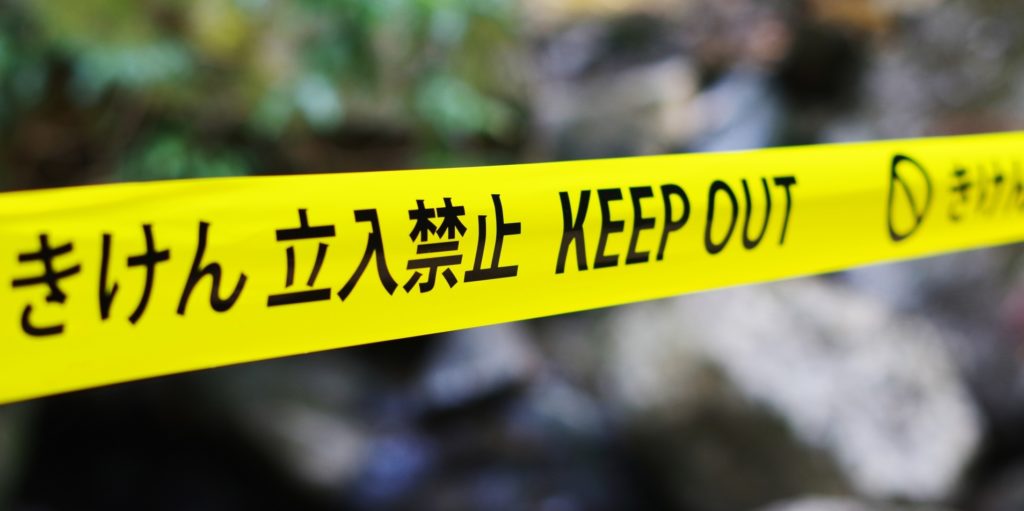
英健康保護局(HPA)は、上記の「3、感染が拡散する3つの可能性」の抑制として、ドクターフィッシュの利用を避けたほうがいい8つのタイプを記している。
もし、あなたが以下8つのどれかに含まれる場合は、ドクターフィッシュの利用は避けたほうがいいので覚えておこう。
- 24時間以内に、シェービングで足のムダ毛処理をした人
- 水に浸す部分に、創傷や皮膚の損傷がある場合
- 水虫などの感染症を患っている人
- 乾癬患者や湿疹、皮膚炎がある人
- 感染リスクの高い糖尿病患者
- B型肝炎、C型肝炎またはHIVなどの血液媒介性ウイルス感染者
- 病気や投薬による免疫不全状態の人
- 出血リスクが高いとみなされる出血性疾患の患者または抗凝固薬の使用者
英国では、ドクターフィッシュの利用によって何らかの症状が出た場合は、医師を受診するか、地域の環境健康当局に報告してほしい、と利用者に呼びかけている。
筆者である私自身は、体調の良し悪しに関係なく、年間365日ほぼ毎日ドクターフィッシュの水質管理を行なっている。手の指の傷から出血があるときでも、水に強い絆創膏(保護テープ)をしっかり貼り、いつも通りの作業を行なっている。それでも、これまでの10年間、何ひとつの症状も出ていない。
5、サービス提供者の水質管理が感染リスクを最小限にする
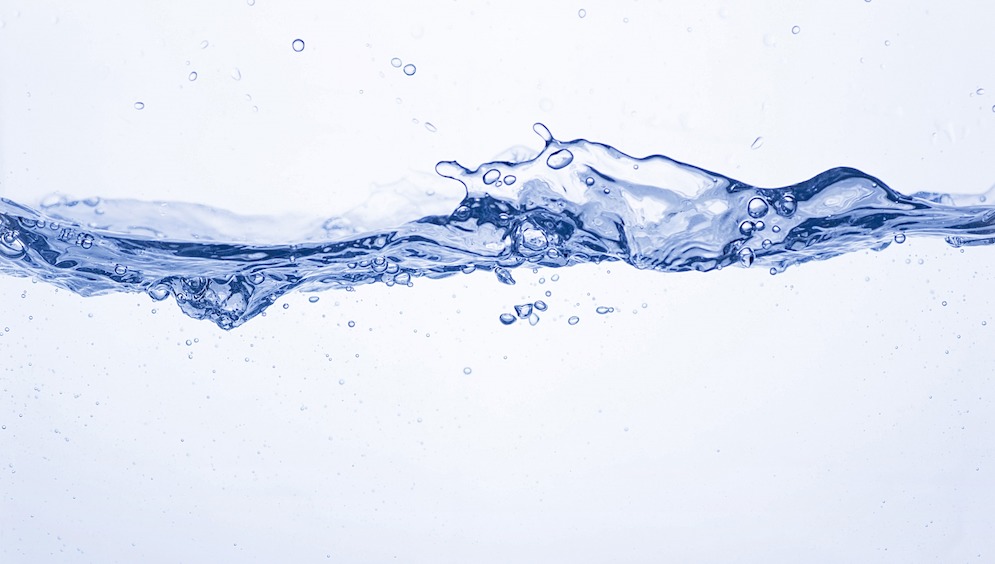
英健康保護局(HPA)は、ドクターフィッシュのサービス提供者に対して、適切な衛生管理の基準が保護されれば、感染リスクは非常に低くなると助言した。
水質管理(良い水質)は、サービス提供者にとって最も重要な業務だ。ドクターフィッシュの良い水質を維持するとは、生体にとって住みやすい環境を整えることだ。
つまり、水質の維持は、利用者への感染リスクを軽減することに加え、魚の健康状態のために重要なことなのだ。
以下が、サービス提供者に対して、ガイドラインで示された内容だ。
- 化学薬品使用の殺菌水処理
- 高光度な紫外線
- ろ過
- 水替え
弊社およびクライアント様で推奨している5つの水質管理
弊社では、ドクターフィッシュ利用者の安全確保のために、以下5つをクライアント様(サービス提供者)に推奨している。
- 良質な水質を維持するために毎日一定量の水替えを行う
- 食用魚の餌と同じものを給餌する
- 殺菌予防のための定期的な薬浴
- 殺菌灯の設備
- 利用者へのアナウンス
これにより、弊社および弊社クライアント様の水質環境下では、過去10年間、感染の被害報告は一度もない。詳しくは『抜群な食いつきのために絶対やるべき5つのドクターフィッシュ飼育法』をご確認いただきたい。
6、まとめ
いかがだっただろうか?
確認された証拠や専門家の合意から、ドクターフィッシュの感染リスクはゼロとは言えないが、非常に低いことがわかった。
しかし、重要なことは、ガイドラインが英国で制作されたものであっても、私たち日本でも同様に、ドクターフィッシュを利用する人とサービス提供者の双方が基礎知識を理解することが、安心して体験できることに繋がるということだ。
あなたにも、ご利用する際の基礎知識を抑え、ドクターフィッシュを大切な方と楽しんでいただきたい。

